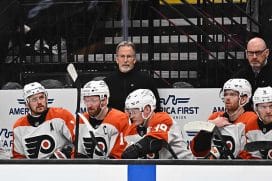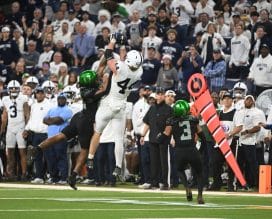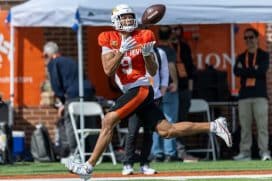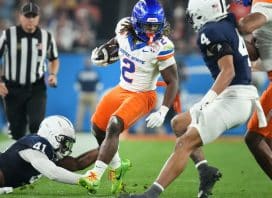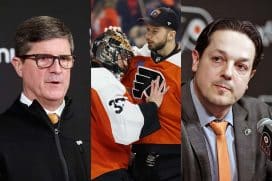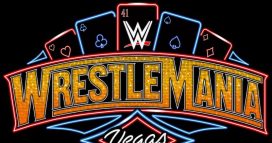Phillies
2017 Phillies Wall of Fame Breakdown – Larry Christenson, Ron Reed, and Gene Garber
By: Matt Alberston, Historical Columnist
The final installment of the 2017 Phillies Wall of Fame breakdown will overview the Phillies careers of Larry Christenson, Gene Garber, and Ron Reed. Each of these candidates were pitchers for the Phillies during the clubs rise to prominence in the 1970s and both Christenson and Reed helped the Phils win their first world championship in 1980. I'll conclude the article with my thoughts on the candidate list overall.
Larry Christenson
Larry Christenson spent his entire 11 year major league career with the Phillies, and was primarily a member of the Phils rotation while occasionally appearing out of the bullpen. He was the third overall pick of the 1972 MLB amateur draft and made his major league debut for the Phillies the very next year on April 13, 1973 at the age of 19. Christenson was a good pitcher, appearing in 243 games, winning 83 while losing 71 and posted a 3.79 ERA. His two best years were in 1977 and 1978 respectively. In 1977, he went 19-6 with a 4.06 ERA for a team that tied a then-club record 101 wins. In 1978, Christenson's record dropped to 13-8 yet he dropped his ERA to a career low 3.24.
Christenson's post-season numbers suffered just like many of the clubs he played for. Most notably, he started Game 4 of the 1980 World Series in Kansas City. The Phillies held a 2-1 series lead going into Game 4. While warming up before the game, manager Dallas Green visited the bullpen to see how his young starter looked and was told "Dallas, he ain't got shit." It was true, he lasted a third of an inning before being pulled for giving up four runs on five hits including a home run to Willie Aikens. That kind stat line resulted in a comedic 108.00 ERA for the game. Game 4 is better remembered for what transpired in the bottom of the 4th inning. Fireball pitcher Dickie Noles relieved Christenson in the bottom of the 1st and in the bottom of the 4th with George Brett at the plate, Noles threw a high inside fastball. Brett demonstrated terrific athletics by somehow dodging the pitch, but the damage was done as Brett struck out. Mike Schmidt credited that moment with turning the tide in the series for the Phillies, despite the Game 4 loss.
Ron Reed
Ron Reed spent 19 years in the major leagues with eight of those years coming with the Phillies. As a Phillie, Reed went 57-38 while primarily a reliever (he only made nine starts in Phillies maroon) and posted a 3.06 ERA.
Reed was signed by the Milwaukee Braves as an amateur free agent in June 1965, just a month after being drafted in the first round of the 1965 NBA draft by the Detroit Pistons. He played both sports until 1967 when he decided to pursue baseball full time. Interestingly, Reed played his final NBA game against the 76ers.
March 4, 1967 Sporting News
Reed was traded to the Phillies after the 1975 season from the Cardinals in exchange for outfielder Mike Anderson. He only made nine more starts over the last eight seasons of his career, but he proved to be an excellent reliever for the Phillies in their rise to prominence in the late 1970s and early 1980s. He appeared in 21 post season games for the Phillies between 1976 and 1983, including 13 appearances in two World Series (1980 and 1983) where he posted a minute 1.69 ERA.
Gene Garber
Gene Garber also spent 19 years in the major leagues. He began his career with the Pirates in 1969 and was purchased by the Phillies from the Kansas City Royals halfway through the 1974 season and spent five years with the Phillies between 1974 and 1978. As a Phillie, Garber was 33-22 with a 2.68 ERA, all out of the bullpen. He was a good reliever best recognized for his strange, Luis Tiant-like windup where he turned his back to the batter in order to hide the ball. Unfortunately for Garber, he was a reliever with two of the greatest Phillies teams of all-time in 1976 and 1977 which ultimately lost to the Reds and Dodgers in the NLCS. He was traded to the Braves halfway through the 1978 season for Dick Ruthven.
2017 Wall of Fame class review
In all honesty, the 2017 class is full of decent players who really shouldn't be considered for the Wall of Fame. The only player who really warrants consideration based on his sustained on field performance is Scott Rolen, who is still relatively unpopular in Philadelphia for the way he handled the end of his time with the Phillies.
Quite simply, it seems abundantly clear that this class was assembled so that one name would stand out: Pete Rose. It's inevitable that Rose will win the fan vote, despite his mediocre statistics, because the fans fell in love with Rose's intensity and experience in big games. Who could forget when he earned a walk against Nolan Ryan in Game 5 of the 1980 NLCS, looked at Ryan, and said "You don't have enough [runs]" or for his clutch backup of Bob Boone in the bottom of the 9th inning of Game 6 of the 1980 World Series. Those are legendary moments that energize a team and a fanbase. So despite Rose's putrid 1.1 WAR in five seasons in Philadelphia, he will be the next member of the Phillies Wall of Fame.
Aside from the fan vote, the club recognizes the economic importance to selling out a game in mid-August, possibly after veterans Howie Kenderick, Michael Saunders, Clay Bucholz, and/or Jeremy Hellickson may depart after posting good first half's, thus greatly improving an already titanic farm system. Rose's induction will again energize the fans in what will likely be the loudest game at Citizen's Bank Park this season.
Let me be clear, Rose was a good player even while he was in Philadelphia, but I think the Wall of Fame is more about ability on the field than the intangibles that influence the other eight men on the field. Yes, I know, "We don't win in 1980 without him." It's a fair statement, but we cannot forget that the Phillies failed to make the playoffs in Rose's first year with the club (1979) after four straight postseaon appearances. What's to say that a more productive first baseman wouldn't have pushed the team over the top in 1980 AND 1983? It's a hypothetical that's ultimately useless, but deserves some thought. Regardless, I plan to be at the park when Rose is inducted on the Wall of Fame, as I imagine many of you will be. It will be a fun day for the franchise and a good day for the fanbase.
Who Else?
I have an ax to grind with the recent Wall of Fame candidate lists. The list of deserving players is dwindling because the Phillies simply weren't a good team by and large for their first 90 years. Nevertheless, there are a few players who are lock, stock, and barrel Wall of Famers:
Fred Luderus: team captain of the 1915 N.L. Champion Phillies and owned the record for most games played at first base for the team until Ryan Howard passed him a few years ago. My feature piece on Luderus' Wall of Fame case can be found here.
Dave Bancroft: A Hall of Famer who was a rookie and the team's starting shortstop for the 1915 N.L Champion Phillies.
Harry Wright: The Phillies manager from 1884 through 1893, Wright presided over the Phillies' first era of sustained success in early 1890s. Wright was born in England and emigrated to the United States and was a crack cricket player but transitioned to baseball and was a member of the infamous 1869 Cincinnati Reds – the first all professional team in history. He was inducted into the Hall of Fame in 1953 and is buried in West Laurel Hill Cemetery in Bala Cynwyd.
Napoleon "Nap" Lajoie: A Hall of Fame second baseman who began his career with the Phillies in 1896 and tore up the National League until he jumped to the American League and cross-town Athletics before the 1901 season.
Three of the above names are tied to the Hall of Fame, yet are mysteriously absent from the Phillies Wall of Fame. Why? Because nobody remembers them. I think if the Phillies want to recognize true greatness before the influx of the 2008-2011 Phillies, these are the four players who should be emblazoned on a bronze plaque in Ashburn Alley.
